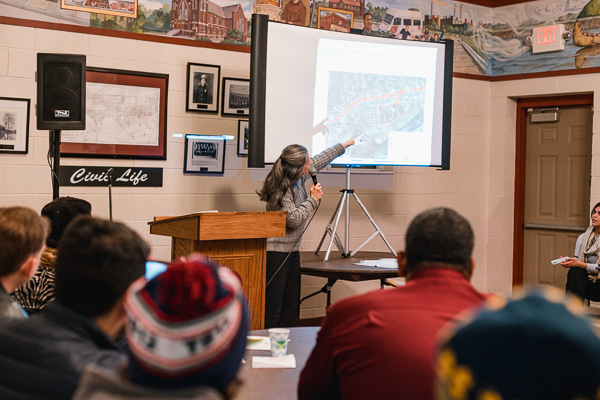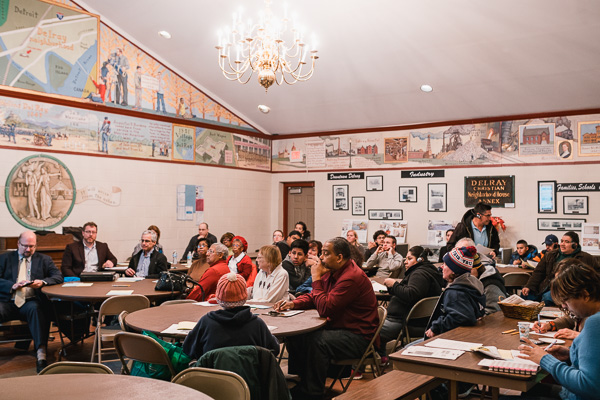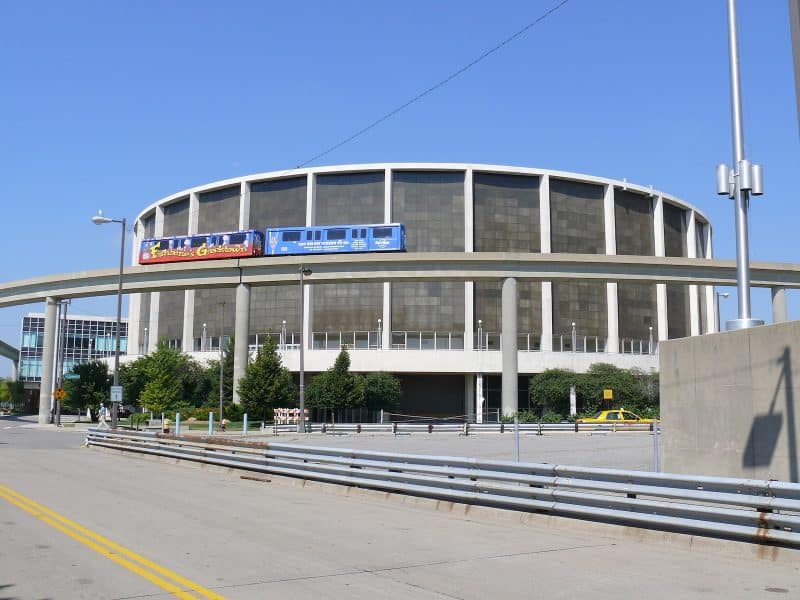How residents of southwest Detroit fought for, and won, a historic community benefits package
The Gordie Howe International Bridge is expected to be an enormous economic boon to Southeast Michigan, but many in southwest Detroit wonder if they'll have access to those benefits. Thanks to a historic deal, they will.
At various times, Delray in southwest Detroit has been called Michigan’s most polluted neighborhood, a “dying” neighborhood, and “a ghost town.” Sitting in the farthest corner of southwest Detroit, it is filled with heavy industry—a Marathon Oil Refinery, Zug Island, a wastewater plant. It has one of the highest rates of asthma in the country.
Delray is not an easy place to live. Now, thanks to the new international bridge development, residents there have the opportunity to move.

Beginning in 2004, there had been discussions between the United States and Canada about building a second bridge in Detroit between the countries in addition to the privately-owned Ambassador Bridge. The Windsor-Detroit Bridge Authority was established in 2012 to acquire land in Delray to make room for its construction.
While the now-named Gordie Howe International Bridge is expected to be an enormous economic boon to Southeast Michigan—$2.2 billion annually by some estimates—many in southwest Detroit, and especially Delray, are wondering if they’ll see similar benefits. Residents there will experience the brunt of the effects from increased automobile traffic, pollution, and noise, and feel they deserve to be compensated.
And thanks to a historic deal made between community organizers, the city of Detroit, and Canada, residents have successfully lobbied for those benefits.
Bridging neighborhoods
The Southwest Detroit Community Benefits Coalition (SWDCBC) was formed in 2008 as a way to get ahead of the new bridge construction and ensure that the already downtrodden residents of Delray weren’t neglected in the process.
“This is a community that is distressed—poor and experiencing the impacts of industry,” says Simone Sagovac, director of SWDCBC. “Now there’s this huge project coming that’s going to double border traffic. So we spent years developing strategies and relationships to advance the cause of securing protections for the community and the impacts that would come.”

In June last year, nine years of dedicated work paid off when it was announced that a $48 million dollar deal had been negotiated between the parties. In exchange for the land Canada needed in Delray for construction of the bridge, customs plaza, and freeway access ramps, residents would receive a suite of benefits.
Bridging Neighborhoods, an initiative of the city of Detroit that will implement the various services, recently opened up a temporary office on W. Vernor Avenue and will soon have a permanent location in the bridge impact area at I-75 and Springwells Street. The office is a one-stop shop for locals to apply for and ask questions about the programs offered.
“If you live in Delray, you’ve lived in spaces of uncertainty for a long time,” says Charity Dean, director of Bridging Neighborhoods. “It’s important to get this program up and running and deliver on promises to the community.”

The initiative’s signature effort is the home swap program. Any homeowner south of Fort Street, plus a few other properties north of I-75—essentially every resident of Delray—is eligible to trade their house for one owned by the Detroit Land Bank Authority (DLBA), the entity that manages city-owned properties. Bridging Neighborhoods will also rehab the house prior to moving in.
“We’re trying to do something that there is no template for,” says Dean. “When the Mayor first asked me to run the program, I researched best practices, what previous cities have done. I found that while other cities have relocated people, no one has ever facilitated it like this.”
The roll-out of the program, which was developed with input from the SWDCBC’s Community Advisory Group, began with an open enrollment period that ended Dec. 15. Applicants were then ranked by their “Delray Score,” which is based on seniority and need. Factors that go into the score are how long a resident has lived in their current home, how close they’ll live to the bridge or plaza, and whether there are children, seniors, or residents in the home with health issues.
Participants take tours of DLBA homes and neighborhoods, rank their top choices, and are matched in order of who has the highest Delray Score.
There are currently 57 families enrolled in the first round of the program, and they’ll begin viewing and choosing homes in March this year. Bridging Neighborhoods hopes to do three rounds and then have another open enrollment at the end of this year.
Dean estimates that there are about 300 owner-occupied homes in Delray and enough funding for 240 swaps. The program has no end date; instead it will continue as long as there’s funding. Sagovac describes it as a “comprehensive program.”
Economic spillover

But with residents leaving the area, many wonder if the bridge will have a net positive impact on southwest Detroit. Other features of the package attempt to ensure that those who remain still get benefits.
Those not eligible for the home swap but still living within 300 feet of the I-75 service drive can get soundproofed windows, air filters, and new heating, ventilation, and air-conditioning systems.
$10 million has been allocated for job training and placement. $2.4 million will go towards air monitors and a health impact study facilitated by the University of Michigan.
The Michigan Department of Transportation and the U.S. Department of Transportation are offering a bonding education program to minority contractors in Southeast Michigan. This program will prequalify many smaller tradespeople to bid as subcontractors for the billions of dollars in infrastructure improvements coming to the region.
The new bridge will also likely cause transit and logistics companies to relocate near the bridge. During construction, warehouses and distribution centers will be in use to park heavy duty equipment. “That will certainly create some economic development,” says Greg Mangan, a real estate advocate for the Southwest Detroit Business Association. “How sustainable that is we’ll have to see.”
But construction, maintenance, and repairs for both the bridge and ancillary developments will be in place for decades to come. City Councilmember Raquel Castañeda-López, who represents southwest Detroit, says this is just “phase one” in a lengthy process of securing benefits for her constituents.
“After many many years of struggling, yes, we’ve got an initial win,” she says. “This addresses a lot of outstanding concerns the community brought up; it’s one step in right direction. And we’ll continue to work forward form there.”
All photos by Nick Hagen.









